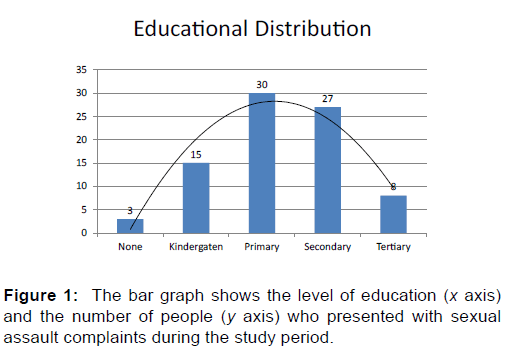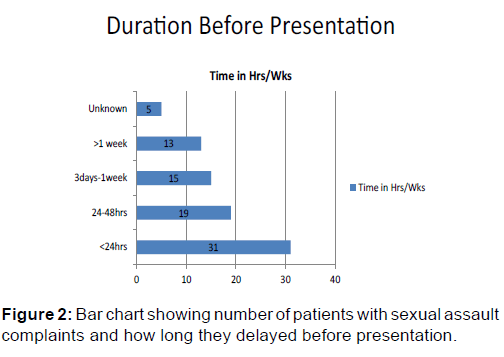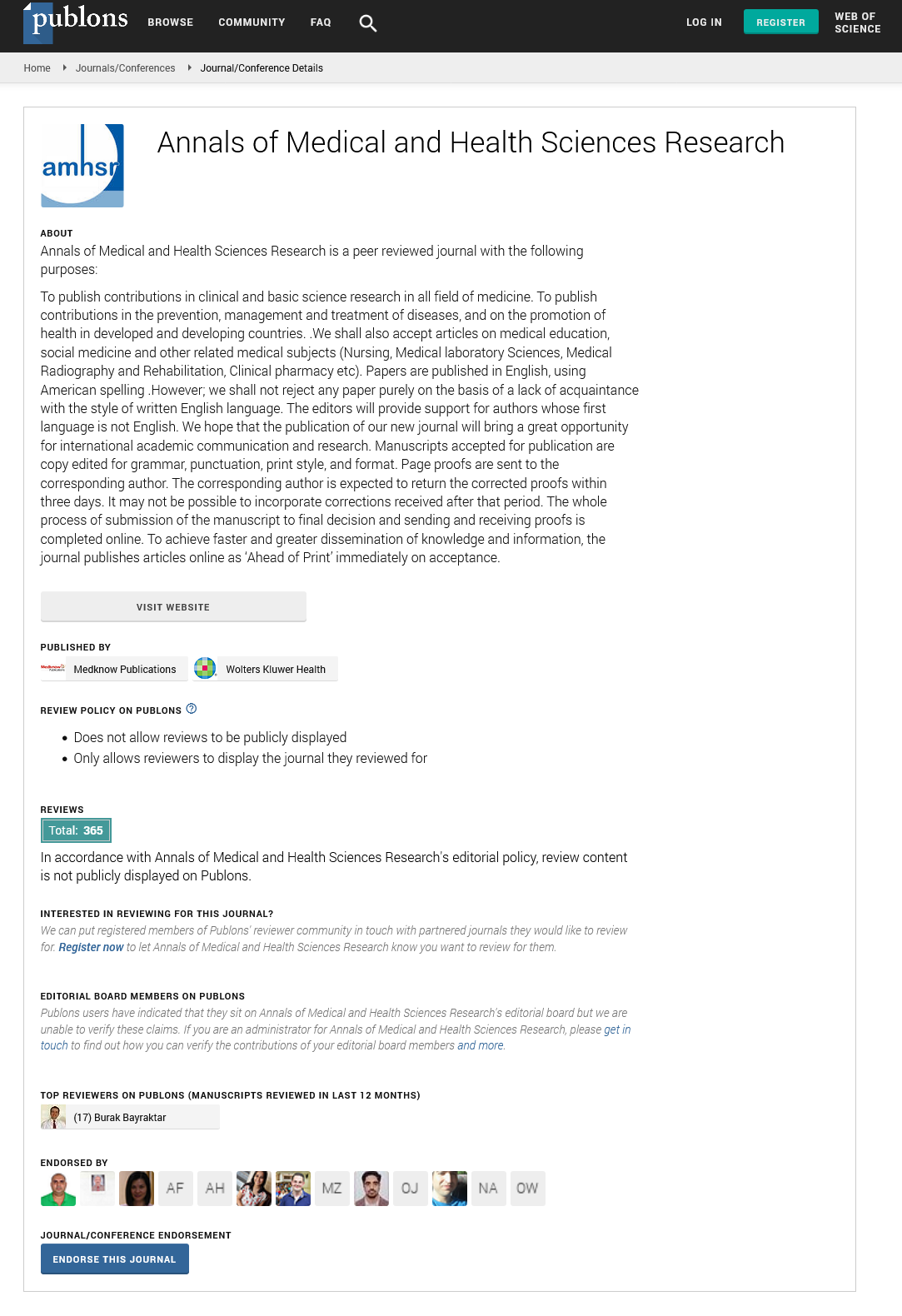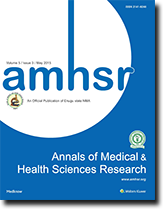The Pattern of Sexual Assault in People Presenting to a Gynaecological Unit of a Tertiary Hospital in South- West Nigeria
2 Department of Medicine, Nigerian Airforce Reference Hospital, Ikeja, Nigeria
3 HICI Healthcare Limited (Research Unit), 73A Lafiaji Street Dolphin Estate, Ikoyi, Lagos, Nigeria
4 Faculty of Medicine, Imperial College London, St Mary Hospital Campus Norfolk Place London W2 IPG, United Kingdom
Citation: Ohihoin AG, et al. The Pattern of Sexual Assault in People Presenting to a Gynaecological Unit of a Tertiary Hospital in South-West Nigeria. Ann Med Health Sci Res. 2018;8:244-247
This open-access article is distributed under the terms of the Creative Commons Attribution Non-Commercial License (CC BY-NC) (http://creativecommons.org/licenses/by-nc/4.0/), which permits reuse, distribution and reproduction of the article, provided that the original work is properly cited and the reuse is restricted to noncommercial purposes. For commercial reuse, contact reprints@pulsus.com
Abstract
Context: Sexual assault is a crime of violence that incorporates unwanted sexual behaviour, such as sexual coercion, uninvited kissing, fondling, touching and ultimately, rape. Individuals prone to sexual abuse are usually the young, poor, and vulnerable members of society, who are often subject to other forms of social vices, such as domestic violence. Aims: To ascertain the pattern of sexual assault in people presenting to a large gynaecological unit of a tertiary referral centre, in Nigeria. Settings and Design: Methods and Material: The study is a descriptive cross-sectional study that was undertaken over a 2-year period from January 2011 to December 2012. Statistical analysis used: SPSS. Results: The prevalence of sexual assault in this study was 1.64%. The majority (90.3%) of victims were single. At least a third (n=35) had secondary education. 62.65% of the patients delayed presentation until after 24hours, (n=52). The commonest reason for delay in presentation was of fear or embarrassment in 51.80% (n=43). The commonest place of assault was at the assailant’s home in 33.7% (n=28). Many cases of assault occurred at night. 63.65% of the victims wanted suspects to be prosecuted (n=53). 67.46% of the victims expressed the desire to take legal action (n=56). Only 51.80% of the respondents (n=43) were aware of a route of seeking re-dress. Conclusions: Victims of sexual assault delay their presentation to health facilities because of fear and embarrassment. A significant percentage of the victims do not know how to obtain medical help.
Keywords
Sexual assault; Victims; Pattern
Introduction
Sexual assault, a crime of violence, incorporates unwanted sexual behaviour, such as sexual coercion, uninvited relations and ultimately, rape. [1,2] Females are predominantly affected. [3,4] In Nigeria, the sexually assaulted are usually the young, poor, and the vulnerable. [5] Nineteen out of every 20 cases are unreported in Nigeria. [6] Social stigma prevents women from speaking out about sexual abuse. [7]
This study aims to describe the pattern of sexual assault in people presenting to the Gynaecological Unit of a Referral Centre, in Lagos, Nigeria. This study informs future public health measures when seeking to address under-reporting and the silence of victims.
Subjects and Method
This study has a descriptive cross-sectional design and was conducted over a 2-year period from January 2011 to December 31st 2012. A structured proforma was utilized to interview victims of sexual assault who presented to the gynaecological unit of a referral centre, in Lagos, Nigeria. Socio-demographic and clinical variables were extracted from the questionnaire. The questionnaire data were anonymized and the extracted data were analyzed using SPSS for Windows version 20 (IBM Inc., Armonck, New York, USA).
Results
A total of 5,050 patients presented to the gynaecological emergency room during the study period. Of these, 83 presented with complaints of sexual assault, giving a prevalence of 1.64%. The age range was 5-26 years [Table 1]. Most of the complainants were single (90.3%). Among those who presented with complaints of sexual assault, about a third (n=35) had at least secondary education, while only approximately 10% had tertiary education (n=8). Up to two thirds were unemployed (n=55), leaving just a few having skilled employment (n=3) [Figure 1]. The most frequent type of assault was sexual (n=71). 62.65% of the patients delayed presentation until after 24 hours (n=52) [Figure 2]. The commonest reason for a delay in presentation to medical services was of fear or embarrassment in 51.80% (n=43) [Table 2]. The commonest place of assault was at the assailant’s home in 33.7% of documented events (n=28). Many cases of assault occurred at night - in 28.9% of circumstances (n=24). 81.9% of situations involved a single assailant (n=68). In 85.5% of instances (n=71), the sexual assault was linked to rape. 78.31% of the victims could identify their assailants, as known neighbours or relatives, (n=65). 63.65% of the victims wanted suspects to be prosecuted, (n=53). 67.46% of the victims expressed the desire to take legal action (n=56). Only 51.80% of the respondents (n=43) were aware of a route of seeking redress. 73.49% of the victims, experienced some frustration in seeking help (n=61). All affected patients who presented to the gynaecological emergency unit received postexposure prophylaxis against HIV, prophylactic antibiotics and emergency contraception.
| Age in Years | Frequency | Percentage (%) |
|---|---|---|
| <5 | 15 | 18.1 |
| 6 - 10 | 26 | 31.3 |
| 11 - 15 | 18 | 21.7 |
| 16 - 20 | 15 | 18.1 |
| 21 - 25 | 4 | 4.8 |
| >26 | 5 | 6 |
Table 1: Age distribution of patients presenting with a history of assault.
| Reasons For Delay | Frequency | Percentage (%) |
|---|---|---|
| Fear, Shame | 21 | 25.3 |
| Ignorance | 10 | 12 |
| Illness | 1 | 1.2 |
| Inability to Apprehend Alleged Rapist | 1 | 1.2 |
| Assault Happened at Night | 1 | 1.2 |
| Lack of Money | 2 | 2.4 |
| Need Advice from People | 1 | 1.2 |
| No Delay | 1 | 1.2 |
| Parent were not Around | 1 | 1.2 |
| Police Protocol | 11 | 13.3 |
| Referral Delay | 1 | 1.2 |
| Threat by Assailant | 1 | 1.2 |
| Weak from side effects of PEP Drugs | 1 | 1.2 |
Table 2: Table showing the frequencies of the underlying reasons for delay before presentation of patients with sexual assault complaints.
Discussion
The prevalence of sexual assault in this study was 1.64%. This is higher than that reported by Ezechi and co-workers in a dedicated HIV treatment centre in Lagos and lower than the report from Akinlusi. [3] Although lower rates have been reported in other parts of Nigeria, the highly cosmopolitan nature of Lagos with exposure to “night life”, unbridled substance abuse, and the busy nature of parents and guardians may be an explanation for the slightly higher prevalence observed in this study, when compared to some other parts of the country. A much higher prevalence of sexual assault has been documented in studies conducted in South-Africa and parts of India. [8,9]
It must be noted however that in our study, the reported prevalence was from a dedicated gynaecological emergency unit and sexual assault of male victims are therefore not captured. The denominator of the variable used for the estimation of sexual assault could also be a factor, as the denominator consists of patients presenting to the gynaecological emergency unit and not patients who visit the clinic for other reproductive health challenges. This could “over-concentrate” the denominator and thus falsely giving a higher than expected prevalence.
In the study conducted by Ezechi and team, they emphasized the need to have a consensus for the estimation of prevalence of sexual assault by using a harmonized denominator. [6] Another aspect that needs harmonization of rates is that related to estimation of rates in sexual assault of females and males together or females alone. [6]
The age range of patients in this study was between 5-26 years of age. This is similar to reports from other workers who reported that sexual assault is commoner among children, adolescents and young adults. [3,7,10,11] These categories of individuals are particularly vulnerable due to their inability to assert themselves, given that they are still dependent on older individuals for most of their needs. [3] The study noted that over 75% of individuals experiencing sexual assault are below the age of 15 years, consistent with Akinlusi’s work. [3] The extremely young age group of pre-school children may not be able to communicate that they are being abused, and this makes them extremely vulnerable.
Adolescents have a higher tendency to be assaulted and they are more likely to present late for intervention. [12,13] Nevertheless, it must be noted that the age range in this study is relatively narrow when compared to other workers who has given reports of upper age range of as much as between 42 and 85 years and a lower age range of between 1yr and 5years respectively. [14]
Delay in presentation was seen as a challenge in this study as over 62.5% of the patients delayed presentation until after 24 hours with a significant proportion presenting within a 72 hour period. Presentation within 72 hours is an important index in cases of sexual assault as it allows victims of sexual assault to access post-exposure prophylaxis intervention and also allow them the opportunity to access emergency contraception. [15] Early introduction of antibiotics will also help to mitigate against the risk of sexually transmissible infections (STI).
Analysis of the reasons for a delay in presentation revealed that most of the victims prevaricated because of a sense of fear and also the embarrassment that they envisaged. This was the reason for delay in 51.80% of the victims (n=43). Fear and embarrassment are associated with stigmatization of victims of sexual assault. Other reasons for delay in presentation include the prolonged and difficult procedures by the law enforcement agencies and the hazardous legal processes. This was a reason for delay in 13.3% of the patients. These findings are similar to studies done by Akilusi, Ezechi and Adefolalu, all of whom documented similar reasons for a delay in presentation. [3,6,16]
The commonest location for the assault was the assailant’s home, as seen in 33.7% of the respondents (n=28). This is similar to Ezechi’s study which also noted the assailants home as the commonest place of assault. [6] A possible explanation for this finding may be related to the average age of assaulted victims being within the younger age range of adolescents; these were young adults who were vulnerable and who could easily be deceived to visit the homes of potential predators who could then take advantage of them. However, this contradicts the findings of Al-Azad and colleagues where the assault mostly occurred at the victim’s house. [5]
In this study, cases of sexual assault were not selective in terms of time of occurrence, as sexual assault occurred during the day, as well as at night. In 81.9% of circumstances, (n=68), one assailant perpetuated the assault . This finding is also similar to findings from other studies. [12] In 85.50% of respondents, there was an associated rape of the affected individuals, thus demonstrating that rape is quite common in cases of sexual assault. This corroborates the results of the study by Draughon and colleagues. [17]
Assailants in this study were familiar to the victims of sexual assault in 78.3% of cases. This finding has been corroborated by other researchers within Nigeria and abroad. [5,6,12,15] First degree relatives, neighbours and individuals in authority, such as teachers, have been shown to be involved in sexual assault. [18,19] Being familiar with the assailants makes it less likely that offenders will be prosecuted as there is a greater tendency to “sweep cases under the carpet” when first degree relatives are involved as assailants. There is a need to ensure that victims of sexual assault obtain the justice that they deserve by allowing victims to come forward in a “no-blame” culture. Although 63.50% of the respondents wanted suspects to be prosecuted (n=53), only 51.80% of the respondents were aware of the route of justice as ignorance of the law, and its processes is still a major challenge to initiating proceedings to prosecute offenders.
Conclusion
Only 32% of the respondents had achieved secondary school level of education (n=32) with 9.6% (n=8) going on to university. The majority were poorly educated, which is consistent with Al- Azad’s results, where the complainants were less educated and of a lower social class. [5] This finding tends to lay credence to the fact that victims of sexual assault are young females who are not empowered and thus vulnerable due to their low socioeconomic status. Another finding from the study that supports this stereotype of victims of sexual assault is the finding that 96.38% of the patients were unemployed and unskilled individuals. This profile of victims of sexual assault has been described by some other authors. [20,21]
This study documents the reticence of sexual assault victims to come forwards for medical assistance. It underlines the need for public health campaigns to educate the public about the need to obtain prompt assistance, particularly with respect to HIV prophylaxis. Furthermore, social awareness campaigns should be encouraged to publicize routes for justice for those subjected to such sexual violence.
Acknowledgement
SDTR is supported by the Wellcome Trust ISSF Fund at Imperial College London (G75749). He is grateful to the United Kingdom National Institute for Healthcare Research Biomedical Facility at Imperial College London for infrastructure support.
Conflict of Interest
The authors disclose that they have no conflicts of interest.
REFERENCES
- Heise I, Moore K, Toubia N. Defining “coercion” and “consent” cross-culturally. SIECUS Rep. 1996;24:12-14.
- Gurvinder K, Dinesh B. Sexual violence against women: understanding cross-cultural intersections. Indian J Psychiatry. 2013;55:244-249.
- Akinlusi FM, Rabiu KA, Olawepo TA, Adewunmi AA, Ottun TA, Akinola OI. Sexual assault in Lagos, Nigeria: a five year retrospective review. BMC Womens Health. 2014;14:115.
- Haile RT, Kebeta ND, Kassie GM. Prevalence of sexual abuse of male high school students in Addis Ababa, Ethiopia. BMC International Health and Human Rights 2013;13:24.
- Al-Azad MAS, Raman Z, Ahmad M, Wahab MA, Ali M, Khalil MI. Socio-demographic characteristics of alleged sexual assault (rape) cases in Dhaka city. JAFMC 2011;7:21-24.
- Ezechi OC, Adesolamusa Z, David AN, Wapmuk AE, Gbajabiamila TA, Eugeniaidigbe I, et al. Trends and patterns of sexual assaults in Lagos south-western Nigeria. Pan Afr Med J. 2016;24:261.
- Tjaden P, Thoennes N. Full report of the prevalence, incidence, and consequences of violence against women: findings from the National Violence against Women Survey. NCJ 183781. Washington, DC: U.S. Department of Justice, Office of Justice Programs, 2000.
- The International Crime Victim Survey in Countries in Transition: National reports. Rome, United Nations Interregional Crime and Justice Research Institute, 1998.
- Victims of Crime in the developing world. Rome, United Nations Interregional Crime and Justice Research Institute, 1998.
- Kellogg N. The evaluation of sexual abuse in children. American Academy of Paediatrics Committee on Child Abuse and Neglect. Pediatrics 2005;116:506-512.
- WHO. Background paper to the UN secretary general’s study on violence against children. WHO; Geneva (Switzerland): Global estimates of health consequences due to violence against children. 2006
- Jones SJ, Rossman L, Wynn NB, Dunnck C, Schwartz N. Comparative analysis of adult versus adolescent sexual assault: Epidemiology and patterns of anogenital injury. Acad Emerg Med 2003;10:872-877.
- Finkelhor D, Turner H, Ormrod R, Hamby SL. Violence, abuse and crime exposure in a national sample of children and youth. Paediatrics. 2009;124:1411-1423.
- Riggs ND. Long HG, Markovchick V, Feldhaus KM. Analysis of 1076 cases of sexual assault. Ann. Emerg. Med., 2000;35:358-362.
- Ogunfowokan AA, Olagunju OE, Olajubu AO, Faremi FA, Oloyede AS, Sharps PW. Correlates of Self-Report of Rape Among Male School Adolescents in Ile-Ife, Nigeria. J Interpers Violence. 2016;31:555-571.
- Adefolalu AO. Fear of the perpetrator: A major reason why sexual assault victims delayed presenting at hospital. Trop Med Int Health. 2014;19:342-347.
- Draughon JE. Sexual assault injuries and increased risk of HIV transmission. Adv Emerg Nurs J 2012;34:82-87
- Omaar R, De Waal A. Crimes without purnishment: sexual harrasment and violence against females in schools and universities in Africa. African Rights, 1994.
- Jewkes R, Abrahams N. The epidemiology of rape and sexual coercion in South Africa: an overview. Social Science and Medicine (in press).
- Plichta SB, Falik M. Prevalence of violence and its implications for women’s health. Women’s Health Issues 2001;11:244-258.
- Dickinson LM, De Gruy FV 3rd, Dickinson WP, Candib LM. Health-related quality of life and symptom profiles of female survivors of sexual abuse. Arch Fam Med 1999;8:35-43.






 The Annals of Medical and Health Sciences Research is a monthly multidisciplinary medical journal.
The Annals of Medical and Health Sciences Research is a monthly multidisciplinary medical journal.